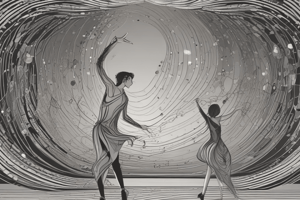Podcast
Questions and Answers
RHYTHM Is a term which denotes an aspect of a quality of movement that is sometimes thought of as ______.
RHYTHM Is a term which denotes an aspect of a quality of movement that is sometimes thought of as ______.
dance
DANCING Is a means of expressing one's emotions through movement disciplined by ______.
DANCING Is a means of expressing one's emotions through movement disciplined by ______.
rhythm
The word dancing came from an old German word 'danson' which means to ______.
The word dancing came from an old German word 'danson' which means to ______.
stretch
ELEMENTS OF RHYTHM: 1.Beat-the underlying pulse of a ______.
ELEMENTS OF RHYTHM: 1.Beat-the underlying pulse of a ______.
Pitch-lowness or highness of a ______.
Pitch-lowness or highness of a ______.
Bar-in music a vertical line across a staff dividing it into equal measures of ______.
Bar-in music a vertical line across a staff dividing it into equal measures of ______.
______-refers to the area covered as the body moves.
______-refers to the area covered as the body moves.
______ is the line of movement taken which may be forward, backward, sideward, diagonal, upward, or a combination of those mentioned.
______ is the line of movement taken which may be forward, backward, sideward, diagonal, upward, or a combination of those mentioned.
______ is movement through space that may be done at high, low, or medium level.
______ is movement through space that may be done at high, low, or medium level.
______ is the path or design that is made while moving in space.
______ is the path or design that is made while moving in space.
______ is a cultural art form handed down from generation to generations.
______ is a cultural art form handed down from generation to generations.
______ is the end-product of exploration and improvisation of movements as the dancer expresses his feelings or emotions.
______ is the end-product of exploration and improvisation of movements as the dancer expresses his feelings or emotions.
Flashcards are hidden until you start studying
Study Notes
Rhythm and Dance
- Rhythm is the regular recurrence of accented and unaccented beats that can be thought of as dance
- Rhythmic activities are the physical manifestations of the mental and emotional response of the individual to rhythm
Elements of Rhythm
- Beat: the underlying pulse of a rhythm
- Tempo: rate of speed of a movement
- Intensity: variation of stress of movement
- Pitch: lowness or highness of a tone
- Accent: emphasis on certain beats
- Meter: regular recurrence of beats that divides a musical design into measures
- Phrase: measures grouped together
- Bar: a vertical line across a staff dividing it into equal measures of time
- Count: a pulse beat, a time limit
- Note: a printed symbol of a musical tone
- Measure: a group of pulse beats
- Note pattern: a note or set of notes with or without rest used for a certain dance step
- Step pattern: the movement of movement
Elements of Movement Space
- Direction: the line of movement taken (forward, backward, sideward, diagonal, upward, or a combination)
- Level: movement through space at high, low, or medium level
- Range: the area covered as the body moves
- Floor pattern: the path or design made while moving in space
Movement Qualities
- Time qualities:
- Fast movements (e.g. galloping horse, jet plane)
- Slow movements (e.g. turtle, flower growing)
- Force qualities:
- Soft and light movements (e.g. fairies, birds, butterflies)
- Strong and heavy movements (e.g. elephant, bulldozer)
- Strong and jerky movements (e.g. frog, jumping jack)
- Smooth and sustained movements (e.g. airplane, fish swimming)
- Space qualities:
- Up and down movements (e.g. bouncing ball, yo-yo)
- Across, back and forth, or around movements (e.g. rowing boat)
- Low movements (e.g. ants, turtles)
- High movements (e.g. kites)
Types of Dance
- Creative rhythms: fundamental rhythms or natural dances
- Folk/ethnic dance: a cultural art form handed down from generation to generation (e.g. rural and country dances, jotas, mazurkas, pandanggos)
- Social and ballroom dance: held in the evenings, participants in formal attire
- Recreational dance: informal gatherings and parties, simple patterns and combinations of walking steps, polka step, and waltz step
- Creative dance: the highest form of dance, an end-product of exploration and improvisation of movements, expressing feelings or emotions, ideas, and interpretations (e.g. ballet, jazz, modern or contemporary dance)
Formations in Rhythmic Activities
- Single Circle, Facing In
- Single Circle, Facing Clockwise
- Single Circle, Facing Counterclockwise
Studying That Suits You
Use AI to generate personalized quizzes and flashcards to suit your learning preferences.




